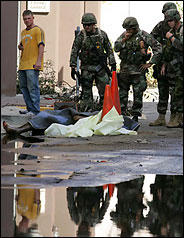Macabre Reminder: The Corpse on Union Street

By DAN BARRY
Published: September 8, 2005
NEW ORLEANS, Sept. 7 - In the downtown business district here, on a dry stretch of Union Street, past the Omni Bank automated teller machine, across from a parking garage offering "early bird" rates: a corpse. Its feet jut from a damp blue tarp. Its knees rise in rigor mortis.
Six National Guardsmen walked up to it on Tuesday afternoon and two blessed themselves with the sign of the cross. One soldier took a parting snapshot like some visiting conventioneer, and they walked away. New Orleans, September 2005.
Hours passed, the dusk of curfew crept, the body remained. A Louisiana state trooper around the corner knew all about it: murder victim, bludgeoned, one of several in that area. The police marked it with traffic cones maybe four days ago, he said, and then he joked that if you wanted to kill someone here, this was a good time.
Night came, then this morning, then noon, and another sun beat down on a dead son of the Crescent City.
That a corpse lies on Union Street may not shock; in the wake of last week's hurricane, there are surely hundreds, probably thousands. What is remarkable is that on a downtown street in a major American city, a corpse can decompose for days, like carrion, and that is acceptable.
Welcome to New Orleans in the post-apocalypse, half baked and half deluged: pestilent, eerie, unnaturally quiet.
Scraggly residents emerge from waterlogged wood to say strange things, and then return into the rot. Cars drive the wrong way on the Interstate and no one cares. Fires burn, dogs scavenge, and old signs from les bons temps have been replaced with hand-scrawled threats that looters will be shot dead.
The incomprehensible has become so routine here that it tends to lull you into acceptance. On Sunday, for example, several soldiers on Jefferson Highway had guns aimed at the heads of several prostrate men suspected of breaking into an electronics store.
A car pulled right up to this tense scene and the driver leaned out his window to ask a soldier a question: "Hey, how do you get to the interstate?"
Maybe the slow acquiescence to the ghastly here - not in Baghdad, not in Rwanda, here - is rooted in the intensive news coverage of the hurricane's aftermath: floating bodies and obliterated towns equal old news. Maybe the concerns of the living far outweigh the dignity of a corpse on Union Street. Or maybe the nation is numb with post-traumatic shock.
Wandering New Orleans this week, away from news conferences and search-and-rescue squads, has granted haunting glimpses of the past, present and future, with the rare comfort found in, say, the white sheet that flaps, not in surrender but as a vow, at the corner of Poydras Street and St. Charles Avenue.
"We Shall Survive," it says, as though wishing past the battalions of bulldozers that will one day come to knock down water-corrupted neighborhoods and rearrange the Louisiana mud for the infrastructure of an altogether different New Orleans.
Here, then, the New Orleans of today, where open fire hydrants gush the last thing needed on these streets; where one of the many gag-inducing smells - that of rancid meat - is better than MapQuest in pinpointing the presence of a market; and where images of irony beg to be noticed.
The Mardi Gras beads imbedded in mud by a soldier's boot print. The "take-away" signs outside restaurants taken away. The corner kiosk shouting the Aug. 28 headline of New Orleans's Times-Picayune: "Katrina Takes Aim."
Rush hour in downtown now means pickups carrying gun-carrying men in sunglasses, S.U.V.'s loaded with out-of-town reporters hungry for action, and the occasional tank. About the only ones commuting by bus are dull-eyed suspects shuffling two-by-two from the bus-and-train terminal, which is now a makeshift jail.
Maybe some of them had helped to kick in the portal to the Williams Super Market in the once-desirable Garden District. And who could blame them if all they wanted was food in those first desperate days? The interlopers took the water, beer, cigarettes and snack food. They did not take the wine or the New Orleans postcards.
On the other side of downtown across Canal Street in the French Quarter, the most raucous and most unreal of American avenues is now little more than an empty alley with balconies.
The absence of sweetly blown jazz, of someone cooing "ma chère," of men sporting convention nametags and emitting forced guffaws - the absence of us - assaults the senses more than any smell.
">1 / 2 Next Page >
Link Here




0 Comments:
Post a Comment
<< Home